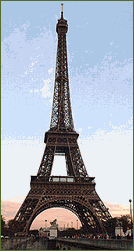|
Constructed between 1887 and 1889, including the 24m antenna, the
Eiffel Tower is 324m high and weighs 7,300 tons, which made it the worlds tallest
structure until 1930 when it was beaten by New York City's Chrysler Building.
The tower can sway 6 to 7cm in the wind and due to the thermal expansion of the metal on
the side facing the sun, depending upon the ambient temperature, the top of the tower may
shift away from the sun by up to 18cm.
The Eiffel Tower in Paris is re-painted every 7
years and it takes around 6 tons of paint to complete it, just to stop this monument from
rusting.
There are three levels in all. At the south towers base a ticket booth sells tickets
to use the stairs, which begin at that location and the first and second levels are
accessible by both stairs and lifts. But the third level summit is only
accessible by lift. On the first platform, the stairs continue up from the east
tower.
Taking the steps is not for the feint hearted, as the actual count of stairs includes 9
steps to the ticket booth at the base of the Eiffel Tower, 328 steps to the first level,
340 steps to the second level, and 18 steps to the lift platform on the second
level. And when exiting the lift at the third level, there are another 15 more steps
to ascend to the upper observation platform. Whether you think this a good idea or
not, the actual step count is printed periodically on the side of the stairs to give you
an indication of your progress!!! But for the majority of the climb, it does allow
you an unhindered view of the area directly beneath and around the tower bar a few brief
times when the stairway is enclosed.
Did you know that the Eiffel Tower was to be demolished in 20 years after
construction? It was due to the fact the Gustave Eiffel was only given a permit for
the Eiffel Tower to stand for 20 years before it passed to the city ready for its
destruction, but because it became valuable as a communications resource, it was allowed
to remain in place even after the permit had expired.
The military even used it to dispatch Parisian taxis to the front line during the First World War and the Battle of the Marne,
and it therefore became a victory statue of that battle.
The tower has two restaurants. The first called Altitude 95 is on the first floor and is at
95m above sea level. The second restaurant is called the Jules Verne, which is on the second floor and
this is an expensive gastronomical restaurant with its own private lift.
The structure was built as the entrance arch for the Exposition Universelle, which was a
World's Fair marking the centennial celebration of the French Revolution, with the Eiffel
Tower being inaugurated on 31 March 1889, and opened on 6 May 1889.
There were 300 workers who joined together 18,038 pieces of puddled iron, which is a very
pure form of structural iron, using two and a half million rivets.
And although the risk of accident was great because of its open frame and only the two
platforms, because Gustave Eiffel took safety precautions only one man died.
But when the Eiffel Tower was built, it was met with resistance, as the public felt it was
an eyesore, even though Parisians today would not wish to be without it, as it is widely
considered to be a striking piece of structural art!
People were also shocked at the daring shape, questioning Gustave Eiffel wondering if he
really was a good engineer, but being that he and his engineers were renowned bridge
builders, he came back with comments stating that it was based on mathematical
calculations utilising wind resistance.
Although most people have the idea that the Eiffel Tower can be seen from almost anywhere
in Paris, this is actually not the case, due to
restrictions in place that limit the height of most buildings to only a few storeys so
there are only a few of the taller buildings that get a clear view of the tower.
|
|



